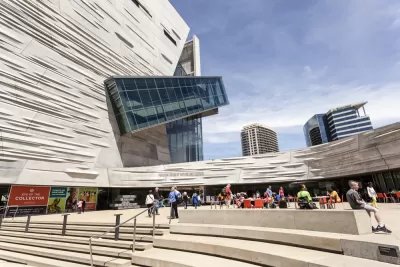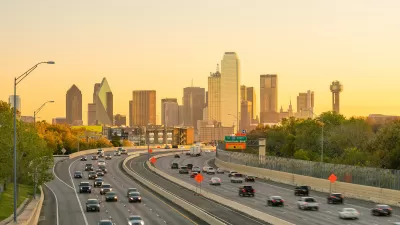Artificial intelligence is being used to generate all kinds of content. Can it successfully replace architecture critics, or does understanding place require physical presence?

After requesting an AI-generated architectural review of the Perot Museum, Mark Lamster, writing in the Dallas Morning News, evaluates the result. Lamster annotates the review with comments, then explains the flaws found in the automatically generated critique.
“To my critical mind, the Perot’s most significant flaw is that it turns its back on the city around it, offering a cold concrete shoulder to the adjacent Arts District. Our computer-generated review suggests just the opposite. Not good.” The review remains glowing, including factual inaccuracies and misunderstandings of the museum’s role in the surrounding neighborhood. As Lamster points out, understanding a building or place requires being there. “But visiting a building in person isn’t possible if the critic isn’t a person at all.”
Because an AI program can’t ‘be there,’ it ends up, like a lazy college freshman, culling what material it can find floating around the internet and regurgitating it in a generic format.”
This may work for public relations, but not for criticism. “Indeed, one of the critic’s essential tasks is to cut through spin, to provide readers with unvarnished, informed opinion, and to do so with a bit of panache.” In Lamster’s opinion, “Of course we all want to be objective (however loaded a term that is, and especially when judging abstract arts), but who wants criticism without personal opinion?”
Ironically, when asked about the limitations of AI-produced critique, ChatGPT nails it, acknowledging its inability to replace, at least for now, human experience and knowledge. The self-awareness of that answer in itself, writes Lamster, “has me worried.”
FULL STORY: Can we replace our architecture critic with a computer? We tried it

Study: Maui’s Plan to Convert Vacation Rentals to Long-Term Housing Could Cause Nearly $1 Billion Economic Loss
The plan would reduce visitor accommodation by 25,% resulting in 1,900 jobs lost.

North Texas Transit Leaders Tout Benefits of TOD for Growing Region
At a summit focused on transit-oriented development, policymakers discussed how North Texas’ expanded light rail system can serve as a tool for economic growth.

Using Old Oil and Gas Wells for Green Energy Storage
Penn State researchers have found that repurposing abandoned oil and gas wells for geothermal-assisted compressed-air energy storage can boost efficiency, reduce environmental risks, and support clean energy and job transitions.

Santa Barbara Could Build Housing on County Land
County supervisors moved forward a proposal to build workforce housing on two county-owned parcels.

San Mateo Formally Opposes Freeway Project
The city council will send a letter to Caltrans urging the agency to reconsider a plan to expand the 101 through the city of San Mateo.

A Bronx Community Fights to Have its Voice Heard
After organizing and giving input for decades, the community around the Kingsbridge Armory might actually see it redeveloped — and they want to continue to have a say in how it goes.
Urban Design for Planners 1: Software Tools
This six-course series explores essential urban design concepts using open source software and equips planners with the tools they need to participate fully in the urban design process.
Planning for Universal Design
Learn the tools for implementing Universal Design in planning regulations.
Ascent Environmental
Borough of Carlisle
Institute for Housing and Urban Development Studies (IHS)
City of Grandview
Harvard GSD Executive Education
Toledo-Lucas County Plan Commissions
Salt Lake City
NYU Wagner Graduate School of Public Service





























